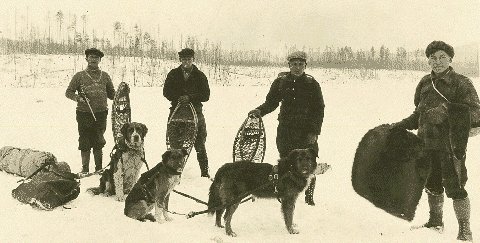|
Back to Presettlement Native History |

BeginningsArriving in Northern Ontario, the early explorers found a land rich in fur: beaver, martin, fox, wolf, and, muskrat. The natives were the first people to harvest fur-bearing animals for food and clothes. By the early 1600's the French had made their way up the St. Lawrence, marking the beginning of the exploitation of this resource. By 1615, Champlain established a trading alliance with the Huron and Odawa Indians, who became the middlemen between the French and Indian nations on the North Shore and St. Mary's River. The Europeans arrived at a time of increasing demand for fur in Europe, and the natives welcomed the superior technology the Europeans brought with them. Pelts were traded for guns, knives, axes, cloth and kettles. The trade had negative effects on the natives. They became dependent on the goods from Europe. They lost their traditional skills. They were exposed to the ravages of liquor, and European diseases. Trade alliances formed between the French and the Huron, and the British and the Iroquois, involved the natives in conflicts which mainly benefited European interests. RivalriesBy 1656, the combined effects of the warring Iroquois and European disease had depleted the Huron tribes. The remaining Hurons moved on to Quebec or joined other tribes. The result was to leave the French with no middlemen. Unlicensed French fur traders pushed west into Lake Superior, and among the first were Pierre Esprit Radisson and Medard Chouart de Groseilliers. On their return to Quebec with a large number of furs, they were imprisoned and their furs confiscated. As punishment for being unlicensed trappers, they were banned from trapping in the St. Lawrence, Great Lakes region. Increased rivalry between the French and the British in 1663 prompted the French to extend their trade areas to Lakes Michigan and Superior. Changing their allegiance to the British, Radisson and Groseilliers went to Prince Rupert, (a cousin of King Charles II), and offered to explore beyond Lake Superior and establish a new trade route. They recommended to the British that a more economical route to Europe could be had through Hudson Bay. Granted a royal charter and a trading monopoly, the Hudson's Bay Company was formed in 1670. The Hudson's Bay Company's monopoly took in the Hudson Bay watershed, known then as Rupert's Land or the Height of Land. This included most of Northern Ontario. Forts were built along the major rivers leading into James and Hudson Bays, and the British encouraged the Indians to trade with them. Letters from the Jesuit missionaries of that time noted the diversion of trade from the French to the British. This was attributed to the influence of the Iroquois on the other tribes, and the British liberality. Hoping to counteract the growing British influence, the French moved to take formal possession of the continent's interior in 1671. At an elaborate ceremony at the St. Mary's Rapids, Simon-Francis Dumont, Sierer de Saint Lusson informed the 14 Indian nations attending that they were now under the protection of the French king, Louis XIV. In 1686, a war broke out between the French and English in Europe, and spilled over into the New World. The French captured British trading posts at Moose Factory, and Lake Abitibi, enabling them to challenge the Hudson's Bay Company across the Height of Land. Under the Treaty of Utrecht in 1713, the French gave up the captured posts, and once more directed their attention to Lake Superior. By 1755, however, the French and British were at war again. French officers were recalled from fur trading posts for military duty. By 1760, the French lost the Battle of Quebec, and the British took over rule of the New World. French posts and traders were now subject to British authority. The North West CompanyStrong competition between Canadian traders and the Hudson's Bay Company led to a partnership between Montreal merchants. The result of this partnership was the North West Company, formed in 1779. The NorthWest Company dispatched traders into the interior to deal directly with the Indians. By 1800, the company had built two posts: one at La Cloche on the North Channel and one at the mouth of the Mississagi River. They had overtaken the Hudson's Bay Company in volume of furs produced. To secure furs from the upper reaches of the Mississagi, Aubinidong and Wenebegon Rivers, a post was built at Green Lake, enabling them to stop the flow of furs over the Height of Land to the Hudson Bay posts. However, the combined effects of fierce competition from Hudson's Bay Company and the cost of transportation led to an amalgamation with their rival in 1820. While retaining an interest in the new company, the North West Company lost their identity and their posts to the Hudson's Bay Company. The role of fur trading ceased to be a major economic force in Northern Ontario in the 1860's. Declining fur-bearing populations led to the first laws controlling trapping in the area. Between 1895 and 1900, economic reasons forced the closure of the Green Lake, La Cloche and Mississagi River trading posts. Recent HistoryStricter controls of the fur industry were enacted in 1916, due to decreasing populations of some fur bearing animals. Although good in theory, due to lack of enforcement the controls were not effective. Trapping licenses were now issued and the sealing or stamping of furs began: each trapper's furs were marked and recorded. The increase in fur bearing populations in the late 1940's was followed by a decline in consumer demand in the 1950's and 1960's. Return to top |
Home | Natural Environment | History | Industry | Personalities/Stories | Credits/Team